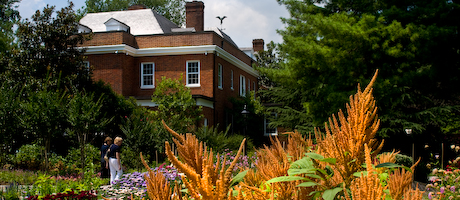By Julia Parmley
Its collection—one of the most extensive of Russian imperial art outside Russia—includes a diamond-covered crown Empress Alexandra wore at her wedding to Tsar Nicholas II in 1894, Faberge eggs owned by the Russian royal family and centuries-old icons.
Founded by Mount Vernon Seminary alumnae and Post cereal heiress Marjorie Merriweather Post, Hillwood Estate and Gardens boasts more than 16,000 artifacts including 18th- and 19th-century Russian art and 18th-century French decorative arts.
“As a museum, Hillwood not only shares Ms. Post’s extraordinary French and Russian decorative arts collections, but the entire estate,” says Estella M. Chung, curator of American material culture and historian at Hillwood. “The architecture and gardens are a historical document of what founder Marjorie Post called, ‘the best way of life that is fast disappearing’ – the American estate tradition.”
Ms. Post already had properties in New York, Palm Beach and the Adirondacks when she purchased Hillwood in 1955. But to Ms. Post, Hillwood would be more than just another vacation retreat: it would serve as a museum for her collection and her life. To realize her dream, Ms. Post hired renowned art historian Marvin Ross to catalogue her collections, help manage acquisitions and transform her estate into a place of wonder and beauty.
According to Ms. Chung, guests at Hillwood merely had to walk around the house to view Ms. Post's vast art collection, which was displayed in glass cases, making coming to Hillwood “a very unique event.”
Many of the rooms in the mansion served special purposes. Ms. Chung says friends of Ms. Post would enjoy a 30-minute cocktail hour before joining in square and round dances and viewings of movies selected by Ms. Post. For larger gatherings, Ms. Post entertained in her French drawing room, which featured French furniture and decorative arts. The room also opened up to her French Parterre, a garden with boxwood hedges shaped in scrolls around a shallow pool, fountains and a statue of the goddess of the hunt Diana, enclosed within ivy-covered walls.
Ms. Post's collection of Russian art could be viewed in the Russian icon room, and Ms. Post often invited local students to tour her collections, which includes two Faberge Imperial Easter eggs and a diamond crown of the Empress Alexandra. Ms. Post's interest in Russian art stems from her third marriage to Joseph E. Davies, who served as the American ambassador to Russia from 1937 to 1938. Ms. Chung says the Soviet Union at the time was viewed as a “mysterious” place, so Ms. Post's collection was both rare and eye-opening for the time. “For the average person to experience art from Russia was very unique,” says Ms. Chung.
Meals in the dining room were made in Ms. Post’s pantry and kitchen, which featured the latest technology of the time. Food was served off of rotating sets of china all previously owned by European aristocrats and by a footman, one for every two guests. For more informal meals, Ms. Post would sit in the breakfast room, a sunny space which overlooked her gardens. Downtime after meals was spent in her library, where portraits of Ms. Post and her family lined the walls.
Today, Ms. Post’s bedroom and sitting room on the second floor are on display for visitors. Decorated in the French style and overlooking her French Parterre, Ms. Post’s bedroom includes a dressing area and a sitting room where she completed most of her personal and business correspondence and met with her 10-15 member staff. The museum keeps a rotating exhibit of Ms. Post’s outfits and jewelry, complete with the original tags and notations from Ms. Post that she recorded for the museum. Ms. Post also spent time in her second floor library, a more informal space with photos of her family and dogs.
Ms. Post’s cultural interests are also reflective in her twelve acres of gardens. Along with the French Parterre, Post has a Japanese-style garden, a rose garden with hundreds of types of roses, a wooden pergola and a memorial monument to Ms. Post; a lunar lawn with more than 7,000 tulips, 3,000 pansies and views of the Washington Monument; a cutting garden for daily floral arrangements, a custom of Ms. Post’s; and a greenhouse which holds 2,500 orchids as well as other flowers.
“Hillwood feels like an escape,” says Lynn Rossotti, head of communications for Hillwood. “Every part of it is a visual experience, and it’s wonderful.”
Hillwood Estate and Gardens receives about 48,000 visitors every year and routinely hosts visiting exhibitions. This season, from Oct. 10 to May 30, Hillwood will feature the exhibit “Sèvres Then And Now: Tradition and Innovation in Porcelain, 1750-2000.” Sèvres is a town in France known for its porcelain manufacturing, and Hillwood will host the first show in American to present early and modern Sèvres pieces together.
Hillwood is located at 4155 Linnean Ave., NW. Hours are Tuesday-Saturday, 10 a.m.-5 p.m. For more information, please call 202-686-5807 or visit www.hillwoodmuseum.org.


